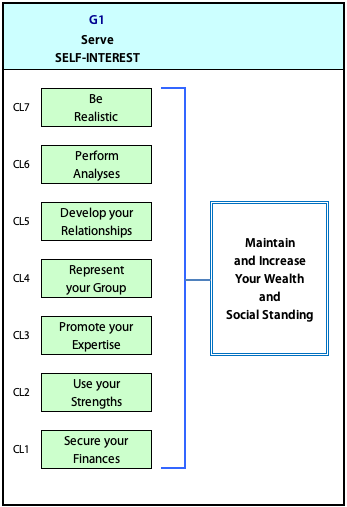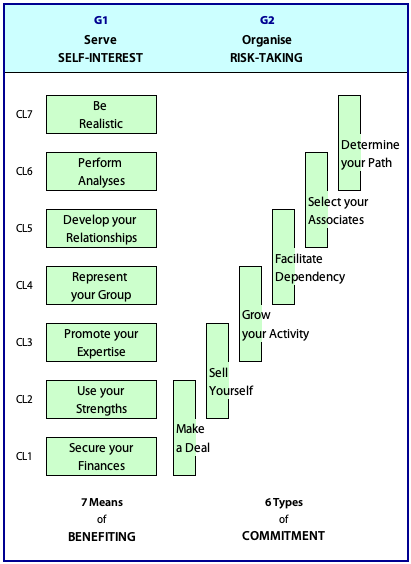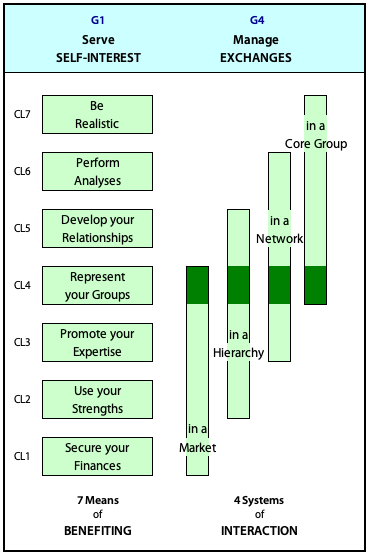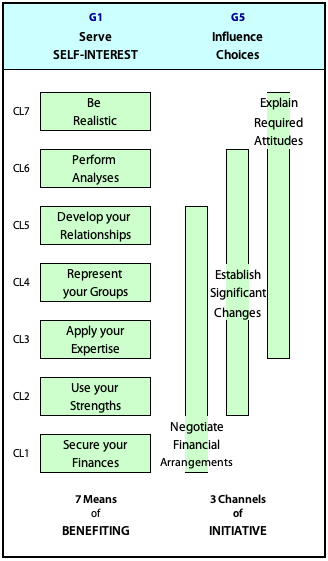Psychosocial Pressures
Single or Dual
In the investigation of Q expansions, we discovered that two psychosocial pressures were in play.
The primary pressure related to the identity (or structure) of the Q-arena. and a secondary pressure related to the operation of the Q-arena.

It has been proposed and tentatively accepted that for both Primary Structural Hierarchies and Spiral Structural Hierarchies, each grouping has a characteristic psychosocial pressure as shown at right i.e. this pattern is based on structure.
A similar pattern appears to apply in relation to at least two Q-Structural Hierarchies:
■ components of PH'2Q1sH, and
■ components of PH'5Q5sH
which strongly suggests general applicability.
It therefore seems likely that this pattern based on structure will apply to the groupings. However, investigation to further establish the validity of this pattern is desirable and it is commenced below.
Secondary pressures have never been considered for structural hierarchies. Is it possible that a secondary pressure based on operating the groups in the groupings also applies? This possibility is also investigated below.
Investigation
Note: Click the thumbnails to be reminded of the group within the grouping.
G1: Serving Self-Interest

Autonomy is the natural structural pressure given the requirement to serve self-interest. Without autonomy, it is hard to know how self-affirmation could operate effectively.
However, in terms of operating the component groups, autonomous choices for benefit appear to be driven by a striving for well-being.
G2: Organising Risk-taking

Understanding is the natural structural pressure because to take risks without knowing what they are would be self-destructive.
However, in terms of operating the component groups, it seems that a proper understanding requires follow through via performance and effective execution.
G3: Handling Exposure

Performance is the natural structural pressure given the focus is speaking up in a way that seeks to be effective and can withstand being criticized and judged by others.
However, in terms of operating the component groups, it seems that you can only perform well if certainty provides the necessary support.
G4: Managing Exchanges

Certainty is the natural structural pressure when navigating markets, hierarchies, networks and core groups and engaging in exchanges.
However, in terms of operating the component groups, it seems that certainty has to be complemented by acceptability for yourself and the other party or there will be no exchange.
G5: Exerting Influence

Acceptability is the natural structural pressure because you cannot influence anyone if you do not take great care to ensure others will accept you and what you have to say. At same time, whatever you do or say must be acceptable in your own eyes.
However, in terms of operating the component groups, it seems that acceptability requires to be further bolstered by selflessness or the other parties will react against your biases, reject your influence and fail to be persuaded.
G6: Maintaining Affluence

Well-Being is the natural structural pressure because wealth is about maintaining your standard of living and the comforts it provides.
However, in terms of operating the component groups, it seems that well-being depends on the application of autonomy in regard to what level of affluence calls for action. This pressure also applies to labeling events as misfortune or activating your energies in the search for greater wealth.
G7: Releasing Aspirations

Selflessness is the natural structural pressure in relation to aspirations, which needs to be something innately within you to which you respond. Aspirations driven by envy or greed are likely to be harmful to yourself and others.
However, in terms of operating your aspirations, the component group, it seems that selflessness requires understanding of yourself, your capabilities and your resources, and also understanding what is happening in your milieu to which you can respond.
Comparison
The pattern that has been identified above is shown in this Table:
| sH-G | 1° Structural Pressure |
2° Operating Pressure |
|---|---|---|
| G7 | Selflessness | Understanding |
| G6 | Well-Being | Autonomy |
| G5 | Acceptability | Selflessness |
| G4 | Certainty | Acceptability |
| G3 | Performance | Certainty |
| G2 | Understanding | Performance |
| G1 | Autonomy | Well-Being |
We can compare this to the pattern found for Q-arenas, which is shown
below:
| Arena | 1° Identity Pressure |
2° Operating Pressure |
|---|---|---|
| Q7 | Selflessness | Acceptability |
| Q6 | Autonomy | Well-Being |
| Q5 | Understanding | Certainty |
| Q4 | Well-Being | Autonomy |
| Q3 | Acceptability | Selflessness |
| Q2 | Certainty | Performance |
| Q1 | Performance | Understanding |
It is evident, but perhaps difficult to see immediately, that the pairings of pressures are identical but reversed i.e. the operating pressure in Q-arenas is the structural (identity) pressure in the sH-Groupings and vice versa.
For easier comparison, this Table reverses the columns:
| Arena | 2° Operating Pressure |
1° Identity Pressure |
|---|---|---|
| Q7 | Acceptability | Selflessness |
| Q6 | Well-Being | Autonomy |
| Q5 | Certainty | Understanding |
| Q4 | Autonomy | Well-Being |
| Q3 | Selflessness | Acceptability |
| Q2 | Performance | Certainty |
| Q1 | Understanding | Performance |
The similarity can be made even more visible by altering the ordering of the Q-arenas to conform to the ordering of the Groupings and combining the two Tables into one as below.
| sH-G | 1° Structural-G 2° Operating-Q |
2° Operating-G 1° Identity-Q |
Arena |
|---|---|---|---|
| G7 | Selflessness | Acceptability | Q3 |
| G6 | Well-Being | Autonomy | Q6 |
| G5 | Acceptability | Selflessness | Q7 |
| G4 | Certainty | Understanding | Q5 |
| G3 | Performance | Certainty | Q2 |
| G2 | Understanding | Performance | Q1 |
| G1 | Autonomy | Well-Being | Q4 |
Here is a more graphic representation of this pattern.

Conclusion
Confirmation of the structural pressures was expected. However, investigating operating pressures is new, and the relation to the Q-arena pattern is entirely unexpected.
The exact nature of the discovery is puzzling.
All we can say is that there seems to be a pairing of pressures in two different taxonomic structures: Q-arenas and structural hierarchies. Q-complexescontain structural hierarchies, but many structural hierarchies are not part of a Q-complex.
There are two immediate mysteries:
► What is the significance of the re-ordering of the pairings as shown in the final table?
► Why is the pairing reversed such that what is primary (structural) in one case is secondary (operating) in the other, and vice versa.
Research on these matters will take place in the Architecture Room in due course. The first research task will be to check other structural hierarchies in THEE for the presence of secondary pressures.
- Return to the Review.
Originally posted: 10-July-2025. Last amended: 10-Oct-2025.